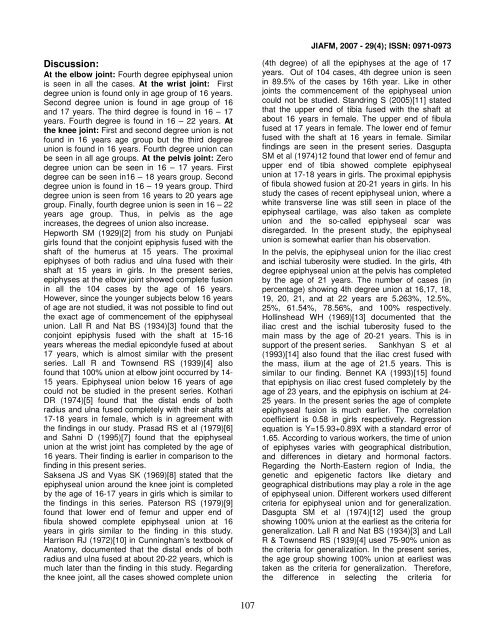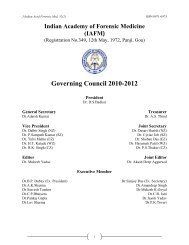Download - forensic medicine
Download - forensic medicine
Download - forensic medicine
Create successful ePaper yourself
Turn your PDF publications into a flip-book with our unique Google optimized e-Paper software.
JIAFM, 2007 - 29(4); ISSN: 0971-0973<br />
Discussion:<br />
At the elbow joint: Fourth degree epiphyseal union<br />
is seen in all the cases. At the wrist joint: First<br />
degree union is found only in age group of 16 years.<br />
Second degree union is found in age group of 16<br />
and 17 years. The third degree is found in 16 – 17<br />
years. Fourth degree is found in 16 – 22 years. At<br />
the knee joint: First and second degree union is not<br />
found in 16 years age group but the third degree<br />
union is found in 16 years. Fourth degree union can<br />
be seen in all age groups. At the pelvis joint: Zero<br />
degree union can be seen in 16 – 17 years. First<br />
degree can be seen in16 – 18 years group. Second<br />
degree union is found in 16 – 19 years group. Third<br />
degree union is seen from 16 years to 20 years age<br />
group. Finally, fourth degree union is seen in 16 – 22<br />
years age group. Thus, in pelvis as the age<br />
increases, the degrees of union also increase.<br />
Hepworth SM (1929)[2] from his study on Punjabi<br />
girls found that the conjoint epiphysis fused with the<br />
shaft of the humerus at 15 years. The proximal<br />
epiphyses of both radius and ulna fused with their<br />
shaft at 15 years in girls. In the present series,<br />
epiphyses at the elbow joint showed complete fusion<br />
in all the 104 cases by the age of 16 years.<br />
However, since the younger subjects below 16 years<br />
of age are not studied, it was not possible to find out<br />
the exact age of commencement of the epiphyseal<br />
union. Lall R and Nat BS (1934)[3] found that the<br />
conjoint epiphysis fused with the shaft at 15-16<br />
years whereas the medial epicondyle fused at about<br />
17 years, which is almost similar with the present<br />
series. Lall R and Townsend RS (1939)[4] also<br />
found that 100% union at elbow joint occurred by 14-<br />
15 years. Epiphyseal union below 16 years of age<br />
could not be studied in the present series. Kothari<br />
DR (1974)[5] found that the distal ends of both<br />
radius and ulna fused completely with their shafts at<br />
17-18 years in female, which is in agreement with<br />
the findings in our study. Prasad RS et al (1979)[6]<br />
and Sahni D (1995)[7] found that the epiphyseal<br />
union at the wrist joint has completed by the age of<br />
16 years. Their finding is earlier in comparison to the<br />
finding in this present series.<br />
Saksena JS and Vyas SK (1969)[8] stated that the<br />
epiphyseal union around the knee joint is completed<br />
by the age of 16-17 years in girls which is similar to<br />
the findings in this series. Paterson RS (1979)[9]<br />
found that lower end of femur and upper end of<br />
fibula showed complete epiphyseal union at 16<br />
years in girls similar to the finding in this study.<br />
Harrison RJ (1972)[10] in Cunningham’s textbook of<br />
Anatomy, documented that the distal ends of both<br />
radius and ulna fused at about 20-22 years, which is<br />
much later than the finding in this study. Regarding<br />
the knee joint, all the cases showed complete union<br />
(4th degree) of all the epiphyses at the age of 17<br />
years. Out of 104 cases, 4th degree union is seen<br />
in 89.5% of the cases by 16th year. Like in other<br />
joints the commencement of the epiphyseal union<br />
could not be studied. Standring S (2005)[11] stated<br />
that the upper end of tibia fused with the shaft at<br />
about 16 years in female. The upper end of fibula<br />
fused at 17 years in female. The lower end of femur<br />
fused with the shaft at 16 years in female. Similar<br />
findings are seen in the present series. Dasgupta<br />
SM et al (1974)12 found that lower end of femur and<br />
upper end of tibia showed complete epiphyseal<br />
union at 17-18 years in girls. The proximal epiphysis<br />
of fibula showed fusion at 20-21 years in girls. In his<br />
study the cases of recent epiphyseal union, where a<br />
white transverse line was still seen in place of the<br />
epiphyseal cartilage, was also taken as complete<br />
union and the so-called epiphyseal scar was<br />
disregarded. In the present study, the epiphyseal<br />
union is somewhat earlier than his observation.<br />
In the pelvis, the epiphyseal union for the iliac crest<br />
and ischial tuberosity were studied. In the girls, 4th<br />
degree epiphyseal union at the pelvis has completed<br />
by the age of 21 years. The number of cases (in<br />
percentage) showing 4th degree union at 16,17, 18,<br />
19, 20, 21, and at 22 years are 5.263%, 12.5%,<br />
25%, 61.54%, 78.56%, and 100% respectively.<br />
Hollinshead WH (1969)[13] documented that the<br />
iliac crest and the ischial tuberosity fused to the<br />
main mass by the age of 20-21 years. This is in<br />
support of the present series. Sankhyan S et al<br />
(1993)[14] also found that the iliac crest fused with<br />
the mass, ilium at the age of 21.5 years. This is<br />
similar to our finding. Bennet KA (1993)[15] found<br />
that epiphysis on iliac crest fused completely by the<br />
age of 23 years, and the epiphysis on ischium at 24-<br />
25 years. In the present series the age of complete<br />
epiphyseal fusion is much earlier. The correlation<br />
coefficient is 0.58 in girls respectively. Regression<br />
equation is Y=15.93+0.89X with a standard error of<br />
1.65. According to various workers, the time of union<br />
of epiphyses varies with geographical distribution,<br />
and differences in dietary and hormonal factors.<br />
Regarding the North-Eastern region of India, the<br />
genetic and epigenetic factors like dietary and<br />
geographical distributions may play a role in the age<br />
of epiphyseal union. Different workers used different<br />
criteria for epiphyseal union and for generalization.<br />
Dasgupta SM et al (1974)[12] used the group<br />
showing 100% union at the earliest as the criteria for<br />
generalization. Lall R and Nat BS (1934)[3] and Lall<br />
R & Townsend RS (1939)[4] used 75-90% union as<br />
the criteria for generalization. In the present series,<br />
the age group showing 100% union at earliest was<br />
taken as the criteria for generalization. Therefore,<br />
the difference in selecting the criteria for<br />
107




![syllabus in forensic medicine for m.b.b.s. students in india [pdf]](https://img.yumpu.com/48405011/1/190x245/syllabus-in-forensic-medicine-for-mbbs-students-in-india-pdf.jpg?quality=85)



![SPOTTING IN FORENSIC MEDICINE [pdf]](https://img.yumpu.com/45856557/1/190x245/spotting-in-forensic-medicine-pdf.jpg?quality=85)

![JAFM-33-2, April-June, 2011 [PDF] - forensic medicine](https://img.yumpu.com/43461356/1/190x245/jafm-33-2-april-june-2011-pdf-forensic-medicine.jpg?quality=85)



![JIAFM-33-4, October-December, 2011 [PDF] - forensic medicine](https://img.yumpu.com/31013278/1/190x245/jiafm-33-4-october-december-2011-pdf-forensic-medicine.jpg?quality=85)

